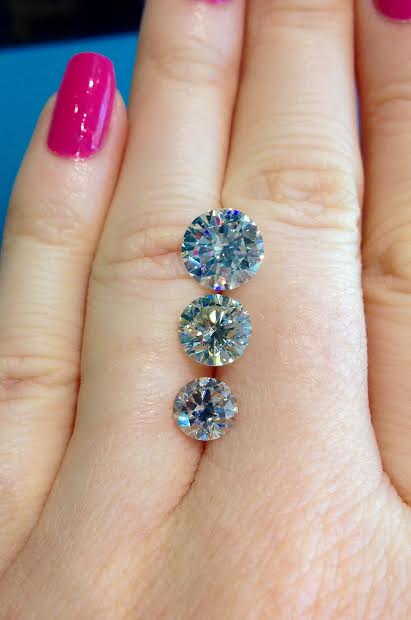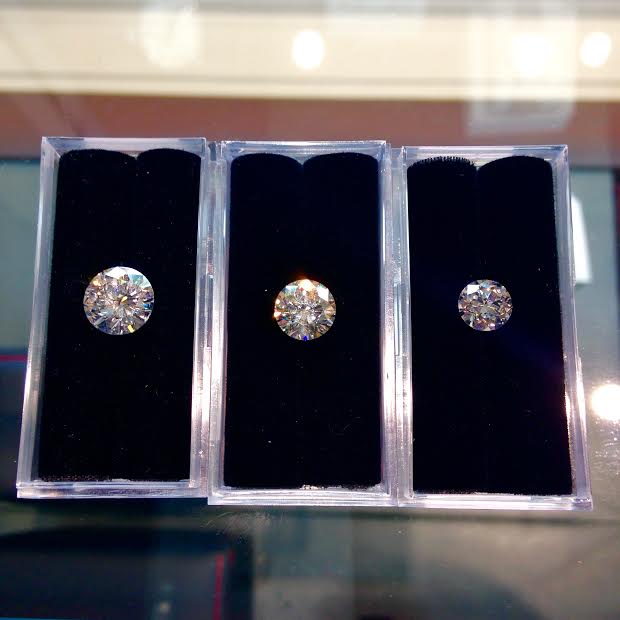
Everything You Need to Know About Carat Weight
When people think about diamonds, the first thing that usually comes to mind is "How many carats?" But you know, as someone well versed in our 4 C's, that carat weight is only one factor that determines a diamond's beauty and value. Each of the 4 C's work together to determine a diamonds' price and appearance, yet carat weight stands head and shoulders above the rest in importance. So, let's start our in-depth dive into the 4 C's with the almighty carat.
[caption id="attachment_34735" align="aligncenter"] From bottom to top: 1.36ct round brilliant, 2.19ct round brilliant, 3.10ct round brilliant[/caption]
From bottom to top: 1.36ct round brilliant, 2.19ct round brilliant, 3.10ct round brilliant[/caption]
The term carat is derived from middle French, but also has roots in Latin and Arabic. It can be traced to the words for “carob”, meaning carob seeds, which were used as a form of trading currency in ancient and medieval markets.
A carat refers to a unit of mass equal to 200 milligrams, and it’s the unit used to measure all gemstones – not just diamonds. 200 milligrams is about the weight of a paperclip, so you could even measure your paperclips in carats. The carat is divisible into 100 points weighing 2 milligrams each - so a 3 quarter carat stone would be .75 carats, or referred to as a 75 pointer.
While carats do refer to a diamond’s weight, they’re mainly used by buyers to discuss a diamond’s size. It’s true that diamonds with higher carat weights can appear to be (and many times are) larger than a diamond with a smaller carat weight, but bear in mind that a diamond’s cut is an influencing factor on its size too. A diamond cut too deep will hold more of its mass at the bottom of the stone, where it can’t be seen. Likewise, a diamond cut too shallow may gain a few millimeters on its crown, but its cut grade - and therefore brilliance – will suffer. But we're jumping ahead.
Because carat is often the “C” that most customers are most familiar with, it is often used as the most important factor in their purchasing decision after the diamond’s price. Each of the 4 C’s work together to determine the price of a diamond because each is a marker of the diamond’s rarity. And the rarer the diamond, the higher the price. This is especially true with carats. To put things in perspective, on average 250 tons of ore must be mined to produce a single 1 carat diamond – the rarity is what you’re paying for when it comes to carat weight.
[caption id="attachment_34734" align="aligncenter"] The same diamonds as above, different viewpoint.[/caption]
The same diamonds as above, different viewpoint.[/caption]
Carats determine the price of a diamond in two ways:
- The overall price.
- The price-per-carat.
Both increase with carat weight. To make things a little bit more complicated, carat weight doesn’t increase in a linear or predictable fashion. So a 2 carat diamond isn’t double the price of a 1 carat diamond. Rather, diamond prices jump around certain carat weights, like 1 carat, 1 and a half carats, etc. The price-per-carat increases at the milestone carat weights I mentioned earlier; a diamond between 1 and 1.49 carats will maintain the same price per carat, before jumping up. The price per carat holds steady at 1.5 through 1.99 carats before jumping again at the 2 carat mark, and so on.
Raymond Lee Jewelers recommends looking for a diamond with a carat weight very close to, but a few points shy of your ideal carat weight when shopping on a budget.
For instance, a 99 point carat diamond might cost significantly less than a 1.01ct stone, simply because the stone 1 point heavier than the milestone 1 carat is in higher demand – and harder to find – than the 99 pointer. Meanwhile, the difference in appearance between the two stones will be impossible to spot with the naked eye. There’s also the possibility that the 99 point carat diamond would appear the same size or larger, thanks to the cut provision I mentioned earlier.
Diamond prices are determined on a weekly basis by Rapaport, and the price list serves as a reference point for jewelers when basing the retail price.
Going back to the effect of carat on a diamond’s size appearance, it’s worth noting that while price increases exponentially, a diamond’s measurements do not. For instance, an H color, SI1 1 ct. round brilliant is currently listed on Rapaport for $6,500. A 2 carat with the same characteristics is listed as $22,800. The difference between the two measurements of the diamonds’ diameter is only 1 and a half millimeters, but the price jumps more than $17,000! On the flip side, this 1.5 mm increase makes the 2ct diamond appear disproportionately larger than the 1 carat, contributing to the higher demand for the larger stone; that demand paired with the exponentially increasing rarity combine to create enormous increases in price-per-carat.
The measurements of a diamond – its approximate size, length by width measurements, diameter and crown to total surface area ratio all affect the diamond’s appearance of size. Moreover, the shape of a diamond can also affect its size. The longer shapes like pear, marquise and oval will appear to be larger than round or square shaped diamonds, even when there’s a minimal difference between diameter measurements.
So, to stretch your budget most if carat is the most important factor for you beyond the “5th c” – cost, Raymond Lee Jewelers would recommend choosing a diamond:
- with an elongated shape
- that falls a point or two shy of your ideal carat weight.
You’ll get an excellent deal on a diamond that’s virtually indistinguishable – particularly if it’s cut well to balance it properly. But again, we're getting ahead of ourselves. Check back tomorrow for our post on diamond Cut!




